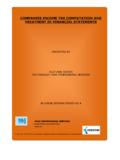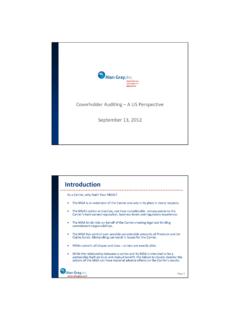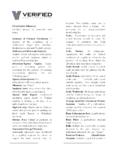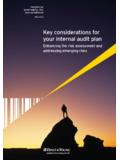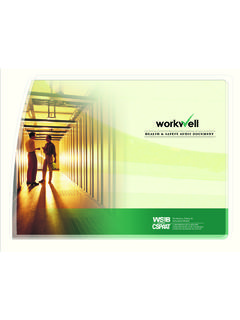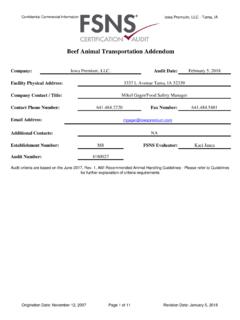Transcription of AUDIT OF SALES, DEBTORS AND PREPAYMENTS
1 AUDIT OF SALES, DEBTORS AND PREPAYMENTS . PRESENTED BY. AUDIT AND ASSURANCE DEPARTMENT: PEAK PROFESSIONAL SERVICES. IN HOUSE SEMINAR SERIES NO 6. PEAK PROFESSIONAL SERVICES. (CHARTERED ACCOUNTANTS). NIGERIA. A member of Kreston International | A global network of independent accounting firms 1|P ag e INTRODUCTION. As part of the year-end AUDIT of a company's financial statements, external auditors test sales transactions and the internal controls over those transactions to ensure that the company is not materially misstating its revenues or accounts receivable. The sales and collections cycle in a business refers to the set of processes that begin when a customer makes a request for the purchase of goods or services and ends when the company receives complete payment for the purchase. The overall objective in the AUDIT of sales and collection cycle is to evaluate whether the account balances affected by the cycle are fairly presented in accordance with relevant accounting standards.
2 It should be noted that there are various accounts that are involved in the sales and collection cycle of a business. The name given to the various types of accounts in the sale and collection cycle vary from business to business. For example, the name given to sales in a retail business will be SALES while in an Insurance business it would be PREMIUM. Though the names differ, it is important to note that the key concepts and principles are the same. DEBTORS and PREPAYMENTS form significant part of the assets of most companies. While sales figure is key to determining the overall result and performance of a business. It is therefore important that the auditor carries out appropriate AUDIT procedures to verify the accounts in the financial statements of a company being audited. This paper covers the AUDIT of Sales, DEBTORS and PREPAYMENTS . It is hoped that at the end of the presentation members of staff will be able to identify the processes involved in any sales cycle and carry out AUDIT procedures to verify the associated balances in the financial statements of our clients.
3 The topics covered in this paper are as follows: Definition of terms Understanding the client's Revenue System Internal Controls over the Sales System AUDIT of the Revenue/Sales System 2|P ag e AUDIT of Cash Sales/ Receipts AUDIT of Accounts Receivable/ DEBTORS AUDIT of PREPAYMENTS Definition of Terms Revenue Revenue is defined by the International Accounting Standard (IAS) 18 as income that arises from the course of ordinary activities of an entity. This could be referred to by a variety of different names such as Sales, Fees, Interest, Dividends and Royalties. It is important to note that sales are generated from the ordinary course of the business. Incomes generated from the activities that are not part of the core business of an entity are regarded as gains and not sales. For instance, sale revenue of a business whose main aim is to sell biscuits is income generated from selling biscuits.
4 If the business sells one of its factory machines, income from the transaction would be classified as a gain rather than sale revenue. DEBTORS Trade DEBTORS also known as account receivables are the value of revenue invoiced for which money is still owed to the business after the sale is made or service rendered. In practice, this usually happens when goods are dispatched or service rendered and invoice issued to the customer. DEBTORS are recorded in the balance sheet of the accounts as a current asset at the time that sales are recorded, but before cash has been received from the customer. The DEBTORS control account in the balance sheet will be the net of all invoices to customers (debits) less the receipts from all customers (credits), and should always be a debit balance. PREPAYMENTS PREPAYMENTS are amounts paid for one period which relates to the next period. They are sometimes referred to as deferred charges and could be related to different expense heads such as Prepaid Rent, Prepaid Insurance, and Prepaid Trade Marks etc.
5 3|P ag e Understanding the Entity's Revenue System We stated at the beginning of this paper that the sales and collections cycle in a business refers to the set of processes that begin when a customer makes a request for the purchase of goods or services and ends when the company receives complete payment for the purchase. The process begins with a request by a customer and ends with the conversion of material or service into accounts receivable and ultimately cash. Kindly note that the process is common to all types of business no matter what they are engaged in. What would be different is the names and degree of details. In order to have a good understanding of a company's sale system, we must understand that every company has specific functions that are associated with the sales cycle. It is important that we understand the functions and the documents that are used for each function whenever we set forth to perform AUDIT on any company.
6 In order to facilitate our understanding of the sales system, we present a summary of the functions in the table below: BUSINESS DOCUMENT ACCOUNTS CLASSES OF. FUNCTION USED AFFECTED TRANSACTIONS. 1 Processing of Customer Sales and Sales customer orders Order/ Sales Accounts Order Receivable 2 Granting Credit Customer Sales and Sales Order/Sales Accounts order Receivable 3 Shipping Shipping Sales and Sales Goods/Rendering Documents/ Accounts Service Waybills, Receivable Certificate of completion etc 4|P ag e 4 Billing Customers Sales invoice, Sales and Sales and recording Bills, Sales list Accounts sales Receivable 5 Processing and Remittance Cash in Bank Cash Receipts recording cash Advice, and Accounts receipts Prelisting of Receivable Cash Receipts 6 Processing and Credit Memos, Sales Returns Sales Returns recording sales Sales Returns and Allowances and Allowances returns and Journals and and Accounts allowances allowances Receivable Journals Accounts 7 Writing off Uncollectible Accounts Write Off of uncollectable Accounts Receivable and Uncollectible accounts authorization Provision for Accounts receivable Journal, General Bad Debt Journal Form Account 8 Providing for Bad General Journal Bad Debt Bad Debt Debts Expense and expense Provision for accounts Bad Debt expense account The table is now explained as follows: When carrying out the AUDIT of a client's sales cycle, we must understand and document the activities in the table above.
7 Such understanding will help us to design the nature of AUDIT test to be performed. It would also help us to fulfill the requirements in ISA 315 Understanding the entity and its Environment. CUSTOMER ORDER. A customer order is a request for goods or service by a customer. This could take the form of telephone, letter or a printed form. The form can be sent by post, hand delivered or by internet. 5|P ag e Sales Order This is a document that is used for communicating the description, quantity or related information for goods or and services ordered by a customer. Sometimes the sales order also includes details relating to credit. It is important to note that before services are rendered or goods are shipped to customer, a properly authorized person must approve credit to the customer for credit sales. Shipping of Goods/ Rendering of Service This is the most important function in the sales cycle.
8 It is the point at which risks and rewards of an asset are transferred to the customer. At this point, most companies recognize income. The document for this important stage is known as the shipping document. It indicates the description of goods, the quantity shipped and other relevant data. The name given to a shipping document could be waybill, bill of laden or any other name depending on the nature of business. Billing Customers Billing customers is the means by which customer is informed of the amount of goods shipped or services rendered. The most important aspects of billing are: All shipments or services have been billed (Completeness). No shipment or service has been billed more than once (Occurrence). Each one is billed for the proper amount (Accuracy). Billing is normally done by means of a sales invoice. A sales invoice is a document indicating the description and quantity of goods sold, the price and other relevant terms.
9 In a computerized accounting system, it is usually possible to obtain what is often referred to as a Sales Transaction File. This file includes all information entered into the system and information for each transaction such as the customer name, date, amount, account classification etc. 6|P ag e This file can also be varied to obtain what is known as the Sales Journal. The Sales Journal is a listing or report which also includes the product line or division. NOTE. The transaction functions explained above are necessary for getting the goods and services into the hands of the customers, correctly billing them and reflecting the information in the accounting records. The other four functions are concerned with collection and recording of cash, sales returns and allowances, write off of uncollectible accounts and providing for bad debt expense. PROCESSING AND RECORDING CASH RECEIPTS.
10 Processing and recording cash receipt involve receiving, depositing and recording cash. Kindly note that cash includes currency, cheques and electronic funds transfer. The auditor's concern here is the possibility of theft and misappropriation of the asset. Sometimes customers will include a remittance advice when making payments, such advice helps the seller to keep track of what has been paid for in order to pass the accounting entries. In the case of electronic funds transfer or purchase of goods by credit cards, the bank provides information to the company to prepare the accounting entries. Most computer system can also generate a cash receipt transaction file that will indicate the name of the customer and invoice details. PROCESSING AND RECORDING OF SALES RETURNS AND ALLOWANCES. When a customer is dissatisfied with the goods or services, the seller often accepts the return of goods and grants a reduction in the charges.
